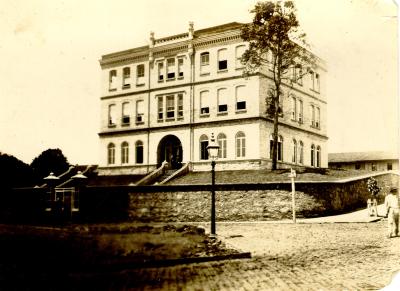The history of Universidade Presbiteriana Mackenzie (UPM), dates back to the 19th century, when Presbyterian missionaries and educators founded it in the city of São Paulo. In 1896 the School of Engineering was opened, giving rise to Mackenzie College, which soon began to offer various courses. In 1952, with a tradition of six decades of higher education, the Brazilian government elevated the institution to the status of university. The UPM seeks to encourage innovation and entrepreneurship throughout its academic community, through institutional policies that result in actions and programs developed in its undergraduate and postgraduate courses, by the Technological Innovation Center, and for its various advanced research groups. Among these researches, those developed by the Mackenzie Radio Astronomy and Astrophysics Center (CRAAM) deserve to be highlighted, which maintains partnerships with other prominent research institutions, such as the National Institute for Space Research (Inpe) and leads the Brazilian Space Geodesy Program, in agreement with NASA (USA), through which it is responsible for an observatory in Euzébio, Ceará, where it maintains the most accurate atomic clock in the country; the Autism Spectrum Disorder Clinic, which investigates and cares for people with this disorder; the Digital TV Laboratory, which played a prominent role in the development of the Brazilian Digital TV standard; the Cognitive and Social Neuroscience Laboratory, which develops non-invasive brain mapping research, working in partnership with international research institutions, such as the Laboratory of Neuromodulation, at Harvard Medical School. The Center for Advanced Research in Graphene, Nanomaterials and Nanotechnology (MackGraphe), with the support of the São Paulo State Research Support Foundation (Fapesp), places UPM at the global forefront in this field of research and will have a strong impact on the industry technology in the next years.

4th PLACE
Americas Most Impactful University of the Year Award
Universidade Presbiteriana Mackenzie
4th PLACE Americas Most Impactful University of the Year Award
UNIVERSIDADE PRESBITERIANA MACKENZIE - Brazil
"One of the most traditional and pioneering Brazilian Universities"

Engage on social media
(Mackenzie: escrevendo boas histórias desde 1870.)
(Escrevendo histórias, formando vidas e construindo o futuro.)
Summary
Key People

Marco Tullio de Castro Vasconcelos
Dean - Rector
Universidade Presbiteriana Mackenzie

Marcos Nepomuceno Duarte
Provost
Undergraduate Studies,
Universidade Presbiteriana Mackenzie

Maria Cristina Triguero Veloz Teixeira
Provost
Postgraduate Studies and Research,
Universidade Presbiteriana Mackenzie

Rachel Neves Dias Francisco
Coordinator
Entrepreneurial Education Center ,
Mackenzie Presbyterian University

Renata Correa Nieto
Coordinator
Mackenzie business incubator coordinator,
Universidade Presbiteriana Mackenzie

Enzo Banti Bissoli
Head Coordination
Student and Career Development - CDD,
Universidade Presbiteriana Mackenzie

Veridiana Rotondaro Pereira
Innovation and Technologies Coordinator
Universidade Presbiteriana Mackenzie
Acknowledgements
Our mission is to educate and care for human beings. We would like to thank all the teams, past and present, from the Entrepreneurial Education Center - NEE, the innovation and research ecosystem at Universidade Presbiteriana Mackenzie, such as the Mackenzie Business Incubator, MackPesquisa, Innovation Center and Center -CIT, Academic Units and all employees who support the logistics and infrastructure of this esteemed institution.
Images

Welcome Mackenzie

Entrepreneurship Awards

Origin 2

Boardgames - Pedagogical - Active Learning and Gamefication

Active Learning

Entrance - UPM

George Alexander - Library

Master Class - 360º room
IMPACT STORY
Impacting lifes
The mission of Universidade Presbiteriana Mackenzie (UPM) goes beyond teaching and research. With a strong ethical-social and ethical-cultural commitment, UPM works tirelessly to train critical citizens who contribute to a fairer and better world for everyone. For more than 148 years, this awareness has guided its actions, demonstrating a deep institutional commitment to society.
UPM stands out in its Social Responsibility and Philanthropy activities, through three main fronts: scholarships, social projects and sports activities. These initiatives create an environment of social inclusion, reflecting Mackenzie's commitment to building a more equitable society.
An example of UPM's transformative impact is the startup founded by a former student, which achieved extraordinary results. This venture not only demonstrates the quality of teaching and training provided by the university, but also highlights how Mackenzie empowers its students to innovate and lead, generating significant changes in the market and society.
This action exemplify how UPM positively impacts people's lives, promoting transformative education and acting with social responsibility to build a better future for everyone.
Startup founded by former Mackenzista shows extraordinary results
https://www.mackenzie.br/noticias/artigo/n/a/i/startup-fundada-por-antigo-mackenzista-mostra-resultados-extraordinarios
LEARNINGS
Lessons learned
The implementation of entrepreneurial actions at UPM has been a journey full of valuable lessons, challenges and achievements. Working on entrepreneurship in different areas of knowledge reveals the complexity and richness of this topic.
One of the main lessons learned is the importance of interdisciplinarity. Entrepreneurship is not restricted to business courses; it permeates all areas of knowledge, from the exact sciences to the human sciences. Each discipline brings a unique and valuable perspective, contributing to the formation of more complete and versatile entrepreneurs. However, this diversity also presents significant challenges. Integrating different approaches and methodologies requires a collaborative effort and the creation of an environment that favors the exchange of ideas and innovation.
Another crucial learning is the need to develop skills beyond technical knowledge. Skills such as leadership, creativity, problem solving and resilience are fundamental to entrepreneurial success. UPM has been committed to providing practical and challenging experiences that encourage students to develop these skills. Extension projects, startup competitions and business incubators are examples of initiatives that promote the integral development of students, preparing them to face the challenges of the job market with confidence and creativity.
Entrepreneurial actions in training not only enrich the academic curriculum, but also broaden students' perspectives, encouraging them to think critically and innovatively. The practical experience acquired through entrepreneurial projects allows students to apply the theoretical concepts learned in the classroom in real situations, preparing them to be agents of change in society.
UPM remains dedicated to fostering the entrepreneurial spirit, aware that this is an essential path to building a more dynamic and sustainable future.
FUTURE PLANS
What's coming?
UPM is committed to expanding and strengthening entrepreneurial education, projecting future actions that seek to integrate innovation, internationalization and extension activities. These initiatives aim to prepare our students for a global and dynamic job market, promoting complete training aligned with contemporary demands.
One of the main strategies for the future is the expansion of international partnerships. UPM plans to establish collaborations with foreign universities, allowing the exchange of knowledge, experiences and good practices in entrepreneurship, applying students' vision about the demands of entrepreneurial projects in other realities. We will intensify exchange programs, workshops and international conferences to offer students the opportunity to experience different cultural and economic contexts, enriching their global vision and capacity for innovation.
Social projects will continue to be a priority, with UPM encouraging students to develop entrepreneurial solutions that meet the needs of local communities. The integration between academic knowledge and social practice will allow students to understand the importance of entrepreneurship as a tool for social transformation, promoting a positive and lasting impact on society.
With these actions, Universidade Presbiteriana Mackenzie reaffirms its commitment to excellence in entrepreneurial education, preparing its students to be innovative leaders and agents of change in an increasingly interconnected and challenging world.

